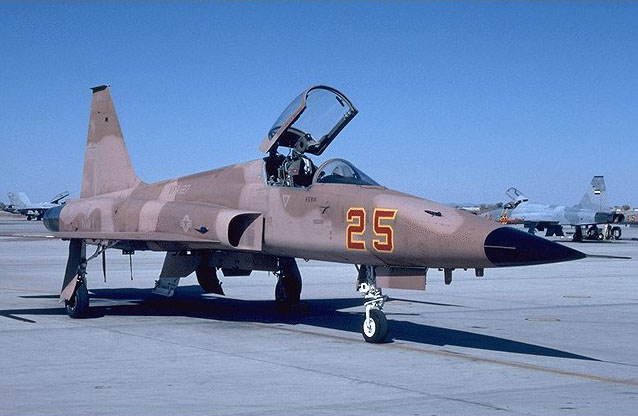
Northrop F-5E Tiger II |

| The development
of the Northrop F- 5 began as far back as 1954 when a Northrop team toured Europe and Asia
to examine the defense needs of NATO and SEATO countries. Three proto-types under the company designation N-156F were built by Northrop in 1958. The USAF serial numbers were 59-4987/4989. The first N-156F (59-4987) was rolled out on 31 May 1959 and was shipped to Edwards Air Force Base. It took off on its maiden flight on 30 July 1959?with test pilot Lew Nelson at the controls. On 9th August 1962, the N-156F was given the official designation of F-5A?and also the official name "Freedom Fighter". The Northrop F-5 family of fighters is unique among American military aircrafts. Although produced in large numbers, not one F- 5 serves in an American combat squadron. They are used mainly for two very different training roles. The best known of these roles is that of a threat simulator in the Air Force and Navy Aggressor squadrons. In this capacity, the F- 5E  and F-5F ( also known as Tiger II ) aircrafts are used to represent
the much-feared Soviet MiG-21 "Fishbed" and Mig-23
"Flogger" fighters. The Tiger IIs are flown by "aggressor" pilots of
the 64th Fighter Weapons Squadron at Nellis AFB. For many years the "aggressors"
adopted strictly Soviet tactics and flight profiles with aircraft adorned in typical
Soviet-style camouflage complete with the intimidating "Red Star". When flown
properly by experienced pilots, the Tiger IIs can defeat just about any fighters in the
air as proven by the Aggressor pilots. It is not a superior aircraft but is a capable one. and F-5F ( also known as Tiger II ) aircrafts are used to represent
the much-feared Soviet MiG-21 "Fishbed" and Mig-23
"Flogger" fighters. The Tiger IIs are flown by "aggressor" pilots of
the 64th Fighter Weapons Squadron at Nellis AFB. For many years the "aggressors"
adopted strictly Soviet tactics and flight profiles with aircraft adorned in typical
Soviet-style camouflage complete with the intimidating "Red Star". When flown
properly by experienced pilots, the Tiger IIs can defeat just about any fighters in the
air as proven by the Aggressor pilots. It is not a superior aircraft but is a capable one.The second form of training in which the Tiger IIs are used, is for the training of foreign pilots in the United States. The Tiger IIs were primarily designed for export and not for use with the US forces. Few American aircraft have enjoyed as much success in allied air forces and many F- 5s are still employed around the world (see table below). However, even big cats succumb to old age and the Tigers are now slowly being replaced by more advanced designs. |
| F- 5E Tiger II Specifications | |
| Length: | 14.72 m |
| Height: | 4.08 m |
| Wingspan: | 8.13 m |
| Wing Area: | 17.28 sq. m |
| Empty Weight: | 6,984.0 kg |
| Gross Weight: | 11,559.0 kg |
| Perfomance | |
| Cruise Speed: | 1,038 km/h |
| Maximum Speed: | 1,731 km/h |
| Range: | 3,726.0 km |
| Climb: | 9,631.21 m/minute |
| Service Ceiling: | 15,849.0 m |
| Propulsion | |
Powerplant: |
Two General Electric J85-GE-21 turbojets |
| Armament | |
| Guns : | - Two
M- 39 20mm cannons in the nose with 280 rounds each. |
| Rockets : | -
Four LAU-3A on wing pylons - Four LAU-3A on wing pylons - One TDU-11/B on wing tip - One SUU-20A/A on centerline |
| Bombs : | - One
MK-84 G.P. - Five M-117A1/D G.P. - Five CBU-24, CBU-49 - Two BLU-27/B, 32/B - Five MK-82 G.P. |
| Missiles : | - Two
AIM-9 Sidewinders are carried on wingtip launch rails. |
Click on thumbnails below to view larger image.
Go to top ![]()
![]()

Aggressor F-5E
ROKAF Tiger F-5E
| F- 5 Designations ( All variants produced ) | |
| N-156 | Pre-production variant |
| F- 5A | Freedom Fighter single-seat variant |
| F- 5B | Freedom Fighter two-seat variant |
| RF- 5A | Tactical Reconnaissance |
| CF- 5A | Canadian Armed Forces single-seat variant |
| CF- 5B | Canadian Armed Forces two-seat variant |
| SF- 5A | Spanish Air Force single-seat variant |
| SF- 5B | Spanish Air Force two-seat variant |
| NF- 5A | Netherlands Air Force single-seat variant |
| NF- 5B | Netherlands Air Force two-seat variant |
| F- 5E | Single-seat Tiger II |
| F- 5F | Two-seat Tiger II |
| RF- 5E | Tiger Eye reconnaissance aircraft |
| F- 5G | Also known as the F-20 Tigershark |
| Countries that have operated the F- 5s | |||
| Bahrain | Malaysia | Sudan | |
| Brazil | Mexico | Switerzland | |
| Canada | Morocco | Taiwan | |
| Chile | Netherlands | Taiwan | |
| Ethiopa | Norway | Thailand | |
| Greece | Pakistan | Tunisia | |
| Honduras | Philippines | Turkey | |
| Indonesia | Poland | USA | |
| Iran | Saudi Arabia | Venezuela | |
| Jordan | Vietnam | ||
| Kenya | South Korea | Yemen | |
| Libya | Spain | ||
Tiger's 
Northrop F-5 Tiger II
- Initial development of the Tiger.
F-5
Worldwide review - Lessons learned from the
Northrop F-5 experience.
This page was updated on Friday, 10 September 2001.